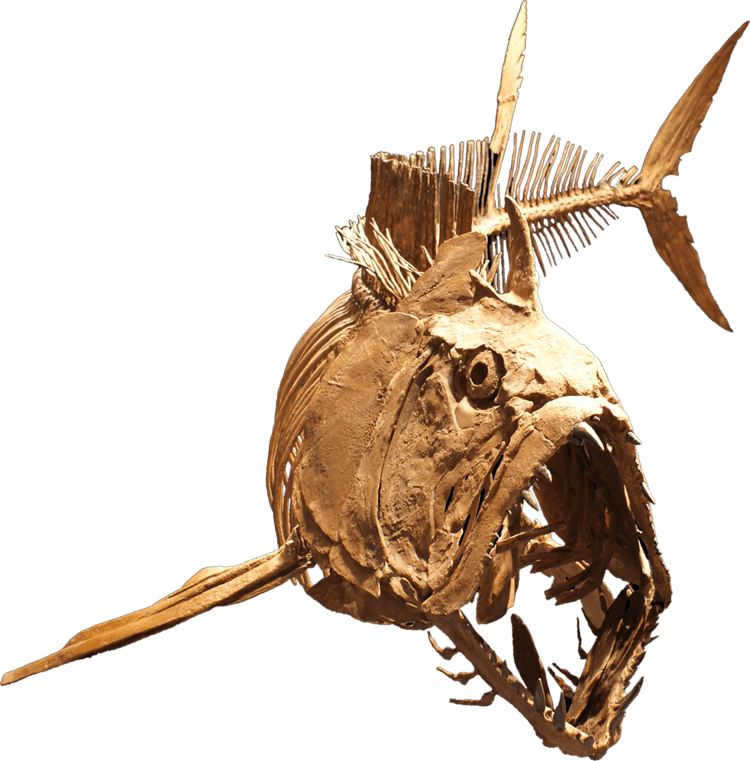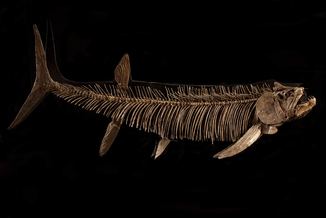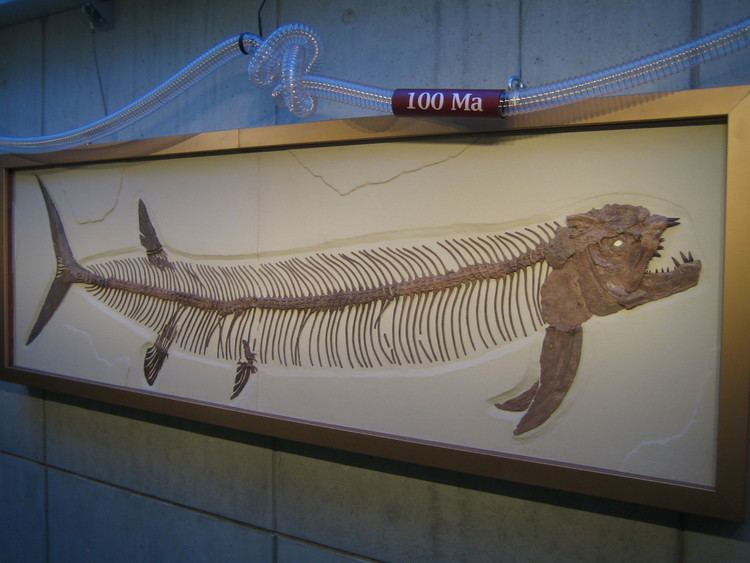Superorder Osteoglossomorpha Subfamily Ichthyodectinae Rank Genus | Family Ichthyodectidae Scientific name Xiphactinus Higher classification Ichthyodectidae Order Ichthyodectiformes | |
 | ||
Similar Tylosaurus, Cretoxyrhina mantelli, Leedsichthys, Gillicus, Placoderm fish | ||
Pdfc the redemption basilosaurus vs xiphactinus
Xiphactinus (from Latin and Greek for "sword-ray") is an extinct genus of large (4.5 to 6 metre; 15 to 20 feet long) predatory marine bony fish that lived during the Late Cretaceous. When alive, the fish would have resembled a gargantuan, fanged tarpon (to which it was, however, not related). The Species Portheus molossus described by Cope is a junior synonym of X. audax. Skeletal remains of Xiphactinus have come from Kansas (where the first Xiphactinus fossil was discovered during the 1850s), and Cretaceous formations all over the East Coast (most notably Georgia, Alabama, North Carolina, and New Jersey) in the United States, as well as Europe, Australia, Canada and Venezuela.
Contents
- Pdfc the redemption basilosaurus vs xiphactinus
- Ppba dakosaurus vs xiphactinus
- Palaeobiology
- Unicerosaurus
- In popular culture
- References

Ppba dakosaurus vs xiphactinus
Palaeobiology

Species of Xiphactinus were voracious predatory fish. At least a dozen specimens of X. audax have been collected with the remains of large, undigested or partially digested prey in their stomachs. In particular, one 13 feet (4.0 m) fossil specimen was collected by George F. Sternberg with another, nearly perfectly preserved 6 feet (1.8 m) long ichthyodectid Gillicus arcuatus inside of it. The larger fish apparently died soon after eating its prey, most likely owing to the smaller fish prey'S struggling and rupturing an organ as it was being swallowed. This fossil can be seen at the Sternberg Museum of Natural History in Hays, Kansas.

Like many other species in the Late Cretaceous oceans, a dead or injured individual was likely to be scavenged by sharks (Cretoxyrhina and Squalicorax). The remains of a Xiphactinus were found within a large specimen of Cretoxyrhina collected by Charles H. Sternberg. The specimen is on display at the University of Kansas Museum of Natural History.

Virtually nothing is known about the larval or juvenile stages. The smallest fossil specimen of X. audax consists of a tooth bearing premaxilla and lower jaws of an individual estimated to be about 12 inches (30 cm) long.

The species and all other ichthyodectids became extinct near the end of the Late Cretaceous – see Cretaceous–Paleogene extinction event.
An incomplete skull of what may be a new species of Xiphactinus was found in 2002 in the Czech Republic, in a small town called Šachov next to Borohrádek city, by 16-year-old student Michal Matějka.
In July 2010 the bones of a Xiphactinus were discovered near Morden, Manitoba, Canada. The specimen is about six metres long and was found with the flipper of a mosasaur between its jaws.
"Unicerosaurus"
In 1982, a former Baptist minister, Carl Baugh, began excavations on the limestone beds of the Paluxy River, near Glen Rose, Texas, famous for its dinosaur tracks. Some of the tracks resembled human footprints and had been proclaimed since 1900 as evidence that dinosaurs and modern humans had once lived alongside one another. Scientists' investigations found the supposed human footprints to be "forms of elongate dinosaur tracks, while others were selectively highlighted erosional markings, and still others (on loose blocks) probable carvings." While excavating, he found a solitary "Y-shaped" fossil that he informally called "Unicerosaurus". In a 1987 popular article, John Armstrong described the fossil as a "Y-shaped petrified bone that appears to be the neural spine from a huge fish like the Portheus of Niobrara Chalk" that Baugh's museum "declared to be the forehead horn of a newly discovered dinosaur genus". The museum's exhibit told visitors that the "horn" belonged to "the unicorn of Job 38, one of three dinosaurs mentioned in Scripture; the others being behemoth and leviathan of Job 40 and 41", and that the horn was able to fold back like the blade of a jack knife. Although some Young Earth Creationists shared Baugh's interpretations of the biblical Behemoth and Leviathan, Baugh's claims were not taken seriously either by Christian organizations or the scientific community.
In popular culture
In October 2010, Kansas House Rep. Tom Sloan (R-Lawrence) announced that he would introduce legislation to make Xiphactinus audax, a.k.a. the "X-fish", the state fossil of Kansas.
